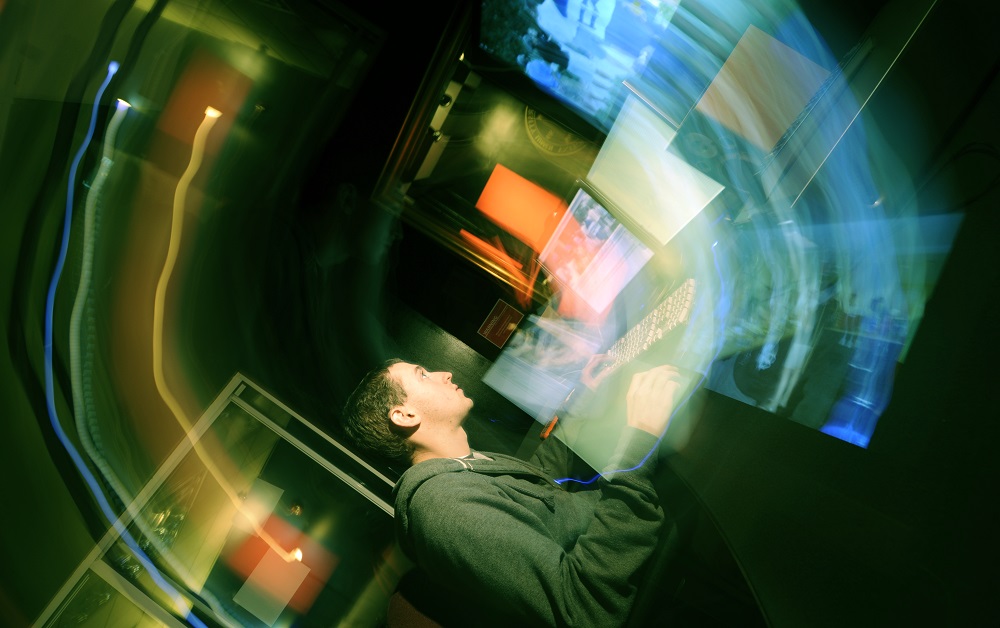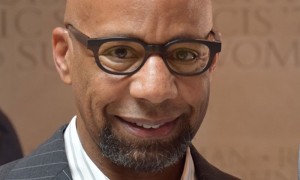Journalism students at Arizona State University this fall took what seemed like a dream class for football fans — “Super Bowl Reporting,” in which they produced content about the lead-up to the Big Game.
“Glass Journalism,” another new course, had journalism students at the University of Southern California vying for one of 12 spots and the chance to don futurist-looking Google Glass eyewear. And at the University of North Carolina, journalism students spent this semester using Objective-C programming language and Apple’s Xcode in a course about designing and developing mobile apps.
These are just a few of the many new courses that debuted this fall at journalism schools around the country, highlighting trends in curriculum development.
Given all the experimenting taking place in journalism education in response to major changes in the news industry, American Journalism Review decided to look closely at new courses rolling out at journalism and communication schools nationwide. AJR contacted 15 prominent journalism schools to ask what new courses they have added over the past two years and what they have in the works for the near future.
The findings suggest that hot areas of curriculum development right now include sports, computer coding, data-driven reporting and digital audience analysis. Also big in course development are the use of emerging technologies such as drones in storytelling.
Not surprisingly, journalism schools have spent much of the past decade revamping their curricula to reflect the major transformation taking place in the news industry. Sweeping curriculum changes can take years to implement, especially when schools add whole new specialties, minors and interdisciplinary majors—all of which has been happening in journalism education.
This fall, for example, the University of Georgia introduced a new certificate program in sports media, Elon University revamped its curriculum to add 13 new courses amid other changes, and USC launched a nine-month master’s degree in journalism.
Next month, the City of New York University’s Graduate School of Journalism is rolling out a new master’s degree in “social journalism.” Next summer, Columbia University Graduate School of Journalism will introduce a data specialization. And in fall 2015, Arizona State will launch new degree programs in sports journalism at both the undergraduate and master’s levels.
Most of these changes took a fair amount of time to implement, and journalism school administrators say they often need to move faster to keep up with the real world.
“I think one of the great challenges for journalism educators is to find ways to keep a curriculum current—quickly—when there can be many administrative layers to go through for full-scale curriculum changes,” said Ted Spiker, interim chair of the journalism department at the University of Florida. “You try to do it in different ways, whether it’s re-inventing a course, making tweaks to a course, or doing special-topics courses that allow you to experiment with all kinds of things that might help our students in their careers.”
For quick change, it’s hard to beat adding a singular specialized course. It allows schools to respond to growing demands for new skills, to particular technologies that emerge suddenly and to new educational theories.
“We have several course numbers that allow faculty to experiment and iterate courses as needed,” said Lynda Kraxberger, associate dean for undergraduate studies at the Missouri School of Journalism.
AJR’s survey showed a wave of new courses popped up just this fall, exploring digital news and communication from many different angles, including all kinds of deep dives into data visualization and social media analysis. School administrators said the courses represent an effort to anticipate where media industries are heading so students will be better equipped to thrive when they enter those fields.
“We don’t want to just serve as a handmaiden to industry,“ said Kathleen Hansen, director of undergraduate studies at the University of Minnesota School of Journalism and Mass Communication. “We want to offer courses that will help our students lead and change their chosen industries for the better.”
Here’s a closer look at a few of the trends AJR found amid the new courses:
Sports Journalism Boom
Thanks to a boom in the business of sports, sports journalism is one of the fastest growing areas of media today, bucking a general downsizing trend prevalent in much of the news industry. Journalism schools have been responding by adding all kinds of courses.
Arizona State University went further last month when its board of regents approved two new bachelor and master’s degrees in sports journalism to debut next fall. Students seeking the specialized degrees will get the chance to cover college and professional games for professional news outlets while working in sports news bureaus in Phoenix and Los Angeles under the supervision of professional sports journalists.

Chris Ramos and Stephanie Edwards, journalism students at Arizona State University, interview Andre Etheir, an outfielder for the Los Angeles Dodgers, at Dodger Stadium.
Mark Lodato, the assistant dean and former TV reporter who leads ASU’s sports journalism program, said career opportunities in sports journalism are expanding beyond regular news into related communication fields.
“Local television newsrooms have fewer sports reporters today than they did 10 years ago, but there are actually more opportunities in sports journalism and communications,” Lodato said. “Many of our graduates are finding journalism and sports and communications-related jobs for high level and profitable websites, and for regional sports networks. We even see recent graduates getting jobs with teams and universities that are producing their own content.”
The new degree program will round out other additions Arizona State has made to its sports reporting roster. “We’ve certainly paid close attention to making sure we’re ramping up our operation,” said Lodato. “In just the last year alone, we’ve hired three full-time faculty members with a sports background.”
ASU is hardly alone.
The University of Georgia this fall launched a special undergraduate certificate program in “sports media” that takes an interdisciplinary approach to sports as news, business and culture. It involves six courses and 18 credit hours, and will award the first certificates to students in spring 2015.
Charles Davis, dean of Georgia’s Grady College of Journalism and Mass Communication, said the certificate program filled the day it was launched and “has drawn rave reviews from students.”
The University of Southern California also added a new sports journalism course this fall called “Sports and Media Technology.” The University of Maryland, which operates a center for sports journalism, recently introduced a course called “How Sports Journalism Constructs Our World,” taught by Kevin Blackistone, a panelist on ESPN’s “Around the Horn” and professor at UMD’s Philip Merrill College of Journalism (publisher of AJR). Blackistone said his course uses media framing theories to explore cultural and social effects of how sports media cover people , events and issues.
Data-Driven Journalism On the Rise
The well-established field of “computer-assisted reporting” is being revitalized and expanded as the digital media revolution generates increasing volumes of data, creating a need for numerically savvy journalists who can filter data, process and analyze it, and present information in clear and meaningful ways. Growth areas in data journalism include both reporting stories (data analysis) and presenting data-driven stories in interactive formats (data visualization).
“We’re now in the age of the numerate journalist,” said R.B. Brenner, director of journalism at the University of Texas, which recently introduced a course called “Data-Driven Reporting.”
Other prominent journalism schools have made similar moves over the past couple of years, often “driven by faculty who see a need, want to fill it, and take the initiative to get it done,” said the University of Florida’s Spiker.
At Florida, Professor Norm Lewis was the faculty member who saw the value of data journalism and a need to make data-reporting courses available to journalism students.
“This semester, when Professor Lewis presented to our Advisory Council – made up of professionals – he brought two students to tell them about the data projects they’re working on,” Spiker said. “When their session ended, many of the professionals got up and gave the students their business cards. I haven’t seen that happen before, and I’ve been here 13 years.”
Columbia University rolled out a new data specialization certificate program this past summer covering the basics of acquiring, analyzing and presenting data. It’s designed to be an intermediate step between a bachelor’s and master’s degree. Students can take either a one-semester or two-semester version of the new “Lede Program,” as it’s called, and will receive a post-bachelor’s certificate. The move comes several years after Columbia introduced a full-scale dual-master’s degree in computer science and journalism.
Stand-alone courses remain popular at other journalism schools. Major schools adding data-driven reporting courses in the past two years include Berkeley, the University of North Carolina and University of Missouri.
Data Visualization Training
In addition to analyzing data, today’s journalists are under pressure to present their findings and share complex information online in accessible, engaging ways. So schools have been scrambling to add data visualization courses that help students highlight key points visually, which can be challenging with complex, data-rich stories.
Data-based journalism courses “[teach] students how to reach beyond the numbers as they tell stories narratively and visually,” said Wanda Garner Cash, associate director of journalism at the University of Texas.
Among the j-schools adding visualization courses in recent semesters have been the University of Nebraska-Lincoln, University of California at Berkeley and University of Missouri.
Missouri’s new “Interactive Data Visualization” course, according to Kraxberger, is designed to produce “journalists who are in high demand – with a wide breadth of skills to help news organizations do good journalism and present it in interactive and meaningful ways.”
The University of Maryland’s journalism school is rolling out a similar new course next semester called “Storytelling with Data Visualization.” It will teach theories of perception, visual mapping and how to find and tell stories through visualizations.
Everyone’s Teaching Audience Analytics
An even newer educational focus than telling stories with data is analyzing how audiences are responding. AJR’s survey showed audience analytics has become a major growth area in curriculum development at almost all of the schools contacted.
The University of Southern California, for example, announced a new course for spring 2015 titled “Connecting the Dots: Data Driven Storytelling for Converged Communication.”
With social media driving a significant amount of traffic to news, a related growth area is teaching students how to analyze the voluminous data generated by social media platforms to help build better strategies for reaching audiences.
Elon University introduced several classes in audience analytics and digital strategy this fall as part of its revamped journalism curriculum. “Strategies for Emerging Media,” for example, is designed to help students “confront the realities of analyzing and interpreting metrics to guide decision-making in competitive media environments” through social media monitoring, targeted messaging and other tools.
The University of Maryland introduced a new course in analyzing social media use in journalism last spring taught by Paul Sparrow, an adjunct member of the faculty and senior vice president of the Newseum. “Understanding how to use social media to reach influencers, source stories and promote great content will be critical skills for today’s students to bring with them into the workforce,” Sparrow said.
USC rolled out a new course this semester called “Real-Time Social Media Monitoring and Analysis for Converged Communication,” while ASU has one in the works called “Search Engine Optimization and Web Analytics.”
Algorithms, Computer Coding and Games
Recognizing the growing value of computer science skills in journalism, a number of journalism schools have introduced courses in computer programming and related computer-science skills in the past few years.
Many journalism schools still send students who want to learn programming over to the computer science department, but a growing number are finding ways to inject programming skills into their own curriculum, AJR reported in September.
UC Berkeley added a course called “Programming for Journalists,” while CUNY and Missouri introduced ones on web scraping which teach journalism students to write code and help them collect data online. This semester, CUNY’s journalism school expanded a course called “Interactivity with JavaScript and JQuery” from five weeks to 10 weeks.
With mobile news consumption growing fast, schools seem keen on helping journalism students learn mobile programming skills. The University of Nebraska-Lincoln and UNC-Chapel Hill are among those that have introduced courses in mobile journalism, with UNC in particular focusing on the design of mobile apps.
J-schools also are experimenting with less traditional uses of programming such as gaming applications.
Courses such as “News Games & Quizzes,” a one-credit, five-week journalism course that CUNY introduced last year, are becoming increasingly common as people see the value of games as news tools. This semester, the University of Minnesota’s journalism school rolled out a new interdisciplinary class, “Digital Games, Sims and App: Storytelling, Play and Commerce,” open to students of all majors.
“The 170 seats in the course filled in the first two days it was open for registration,” said Minnesota’s Hansen. “It is a serious treatment of an industry and an area of professional practice that now surpasses the film industry in terms of sales and investments. We thought it was appropriate for the School of Journalism and Mass Communication to ‘own’ this area of study since this is one of the 21st century’s important storytelling forms and is a major location for informational and persuasive messaging.”
ASU said it, too, is planning a course in “news games” for this coming spring in which students will learn to develop games on news topics.
Emerging Tech: It Never Stops
As technology innovation changes how people communicate, journalists – and journalism schools – face new opportunities and challenges. Each year brings a fresh round of special courses focused on ultramodern technology.
Notable recent examples were “Google Glass” at USC and “Science Investigative Reporting/Drone Journalism” at the University of Missouri, giving students an opportunity to test the usefulness of these new tools in reporting. Similarly, Columbia University’s Tow Center for Digital Journalism ran a special 4-week class last summer on “sensor journalism,” exploring ways to teach students to capture data in the physical world using sensors.
In the near future, The University of Nebraska-Lincoln plans a course on drone journalism, Columbia plans one on “Investigating with Data,” and Missouri is developing one called “Advanced Mobile Storytelling.”
With the Apple Watch, Oculus Rift 3D virtual reality headset and other new platforms slated to roll out soon, you can expect another wave of technology-specific courses next year, along with broader curriculum changes.
“Whether we make small changes in courses or overhaul a curriculum or all the possibilities in between,” said Florida’s Spiker, “our goal is to be as nimble as possible—to help provide a foundation in strong journalistic principles as well as to expose students to what’s new, what’s important, what will get them hired, what will improve journalism, and what will be essential parts of their current and future skill set.”
Correction: An earlier version of this story gave a wrong last name for the dean of Georgia’s Grady College of Journalism and Mass Communication. His name is Charles Davis, not Charles David. It also gave the wrong date for the launch of the Lede Program, it started this past summer.








